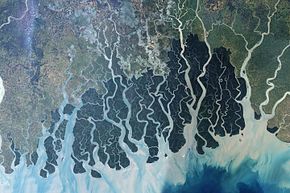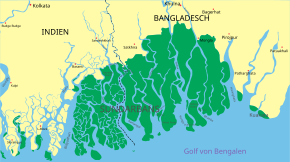Sundarbans
The Sundarbans ( Bengali সুন্দরবন , sundarban , literally "beautiful forest") are the largest mangrove forests on earth . They cover an area of about 10,000 km². About 6000 km² of this is in Bangladesh and 4000 km² in the Indian state of West Bengal .
The mangrove forests are located in a low-lying estuary and floodplain of Brahmaputra , Ganges and Meghna , which carry precipitation from the southern slopes of the Himalayas as well as seasonally large amounts of water from the monsoon zone into the sea. The species-rich ecosystem is difficult to access and widely ramified because the rivers in the Ganges Delta are divided into numerous branches and estuaries . The endangered Bengal tiger and the endemic Sundari tree are native here.
National park and nature reserves
The 1330 km² Sundarbans National Park is located in the western Indian part . This was declared a national park on May 4, 1984 , UNESCO declared it a world natural heritage site in 1987 and a biosphere reserve in 2001 .
On the larger, eastern side in Bangladesh, 1,396.99 km² are protected in three Wildlife Sanctuaries: Sundarbans West (715.02 km²), Sundarbans East (312.26 km²) and Sundarbans South (369.70 km²). These three protected areas were established in 1977 and in 1997 also declared a World Heritage Site by UNESCO.
ecology
landscape
The Sundarbans are in a constant landscape change. The southern areas in particular are subject to changing tides, the animal and plant population has adapted to the brackish water . Floods wash away parts of the forests and leave behind wet desert areas, but new, drier areas are also created by the washing up of sand and mud.
Typical of the mangrove forests are the up to 40 cm high root spurs that drive the roots of many tree species upwards in the oxygen-poor muddy soil. They form a dense “lawn” that can be found on the bottom of almost all groves and makes movement difficult. They are often just below the surface during flooding and impede the movement of boats.
plants
The Sundarbans form a natural protective wall for the inland against the tropical cyclones that regularly approach from the south . Many rare plants can be found here. Mangroves dominate the flooded areas, while bamboo species thrive in the forests further north .
The cyclone Sidr has severely affected the mangrove forest on November 15 of 2007. About a quarter of the stock was damaged. Also, climate change , the rise in sea level , increasing salinization of freshwater areas , oil spills from the nearby port of Mongla and illegal logging threaten the existence of the Sundarbans.
Wildlife
The Sundarbans are home to numerous birds , fish , crocodiles , pythons , deer and wild boars . Larger animal species such as rhinos, Asian cattle and various other ungulates were already exterminated through sport hunting in the colonial times . Today hunting is strictly regulated, but poaching is widespread. The mangrove forests are also considered the retreats of the Bengal tiger , which has become a symbol of the general extinction in this region.
The axis deer is one of the last larger wild animals of the Sundarbans. Coming from the north it populates the mangrove groves and in floodplains it feeds almost exclusively on leaves of the trees, which it eats standing on its hind legs at a height of about two meters and keeps the forests "transparent" at this height. It contributes to landscaping ( megaherbivore hypothesis ). A soil vegetation by grass and leaf plants, as it is typical for other forest forms, is not available to him in the mangrove forests.
In addition to the Bengal tiger, there are many wild boars in the Sundarbans that eat omnivorous (omnivorous), accept carrion and occasionally hunt and prey larger animals such as the axis deer. Lizards are z. B. represented by the white monitor monitor , which swims very well and stays in groups in the woods.
The Sundarbans also seem to be a refuge for residual Goliath heron populations . Today this species has its main distribution center in Africa. In the Sundarbans, however, representatives of this species are observed again and again, so that there seem to be last stocks here.
Influence of man
colonization
Due to the climatic conditions and constantly changing landscape, the Sundarbans are very inhospitable to human habitation and the threat from tropical diseases and parasites is high. Nevertheless, there are numerous local settlements and villages, the residents of which live mainly from fishing for fish and shrimp and from collecting honey . The collection of honey is seasonally limited to a few months and is often done by collectors who have traveled to the area. Shrimp fishing can be done all year round and is done with hand nets.
Fishing
The fishing is done according to an old method with trained otters , who drive the fish from the flooded shallow waters into the fishermen's sink nets , which they lay under the surface of the water from the channels. These nets are stretched in frames and are usually laid and lifted by two people. The largest specimens are then collected by hand from them and passed on daily to dealers who transport them to trading venues. This method is considered ineffective, but very environmentally friendly (see dynamite fishing , cyanide fishing ). There is also no bycatch damage .
Fishermen and otters stay together on the boats during the fishing season. The otters live in wooden boxes with the fishermen, where the offspring are also raised. They are leashed during the hunt. When looking for and playing in shallow water, they often encounter their own predators such as crocodiles and snakes and can be pulled into the boat or prevented from escaping uncontrollably. The line also serves the purpose of keeping otters without offspring with the boat, as they occupy territory and tend to linger in one location, which is not possible due to the fishing work. Otters with offspring do not leave the boat.
Outside the season, the otters stay in the immediate vicinity of the berths and maintain close contact with their owners, sleep in the boxes. The dressage takes place on calls and line signals by throwing smaller fish according to the desired behavior. Experienced otters are of great value to the fisherman. They are, however, extremely agile, maintain a strong play instinct throughout their life and have to be kept busy.
Conflict with carnivorous animals
Despite the declining large game population, numerous large carnivores such as crocodiles, tigers and pigs have kept in the Sundarbans, which among other things feed on human corpses from river burials. A large number of people live in the industrial cities and their slums along the approaching streams who cannot raise the necessary funds for the wood for cremations of their deceased relatives. The corpses are wrapped in cloths, flowers and candles and handed over to the river on their last journey, but collect in the Sundarbans, where they are broken down by microorganisms or used by invertebrates or vertebrates such as wild boars. There are different estimates of the number of bodies.
This development is particularly problematic because the Bengal tiger, which has one of its last refuge areas in the Sundarbans and z. B. fed by axis deer, now also eats from human corpses and the fishermen living there are increasingly being discovered as a source of food. Every year about 25 people are preyed on and eaten by tigers. This particularly affects collectors of wild honey, who pray to the local deity Bonbibi to protect against tiger attacks . The animals are therefore feared and are hunted themselves. There have also been some unproven theories about the reasons the tigers hunt people, including the consumption of salt water.
Individual evidence
- ↑ UNESCO World Heritage List: Sundarbans National Park , India.
- ↑ UNESCO World Heritage List: The Sundarbans , Bangladesh.
- ↑ Evaluation UNESCO (PDF; 2.0 MB)
- ↑ James A. Kushlan & James A. Hancock: Herons . Oxford University Press, 2005, ISBN 0-19-854981-4 , p. 128
- ↑ www.20min.ch - Everyday life with the ogres
Web links
- Search for Sundarbans in the German Digital Library
- Search for Sundarbans in the SPK digital portal of the Prussian Cultural Heritage Foundation
Coordinates: 21 ° 56 ' N , 88 ° 51' E







